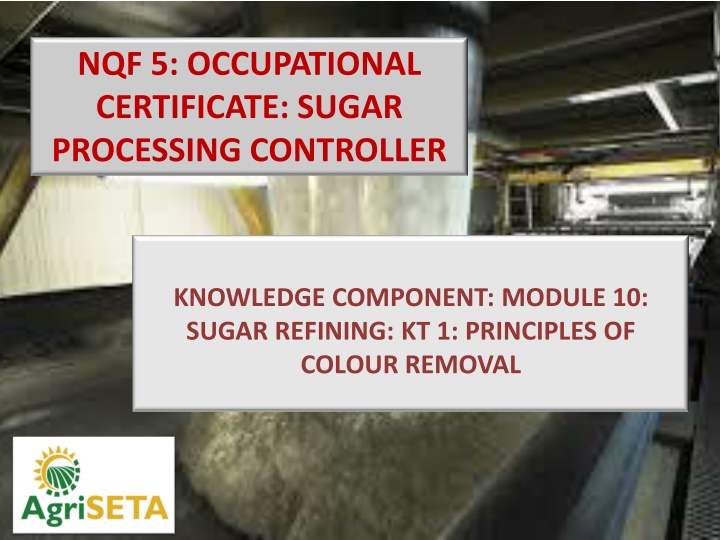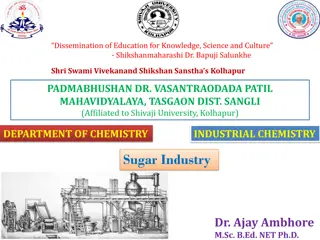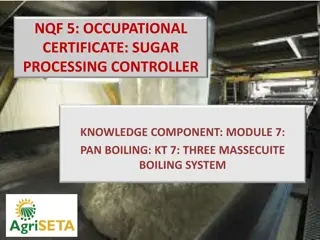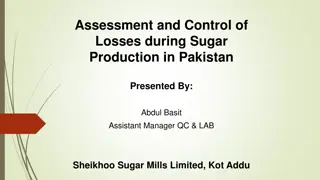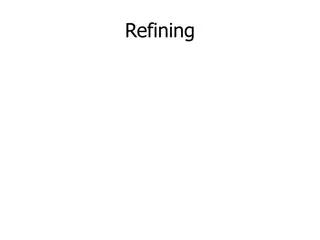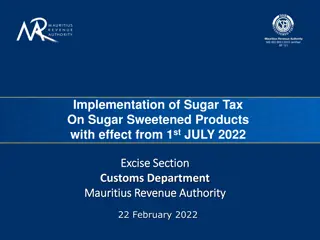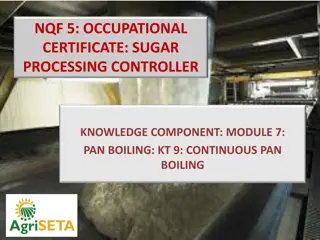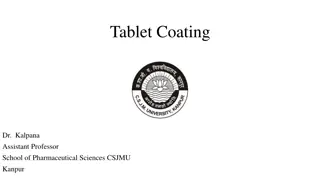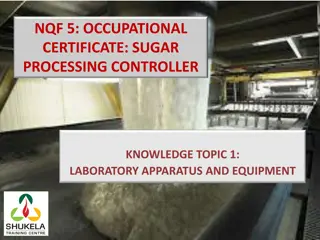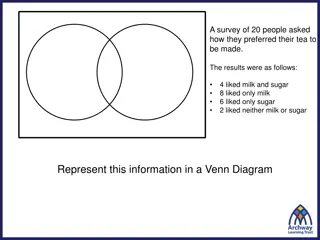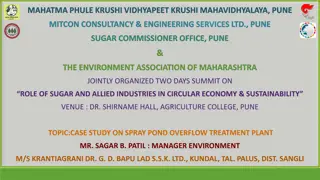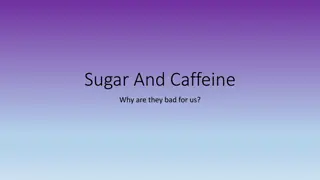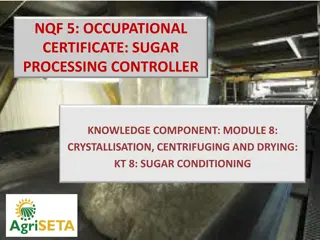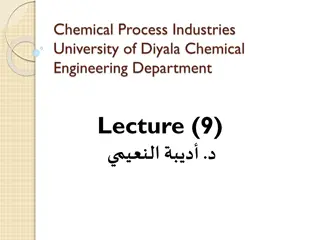Principles of Sugar Refining: Effects and Mechanisms
Effect of raw sugar quality on refining ash, colorants in sugar, and mechanisms of color removal in sugar refining processes. Learn about the impact of impurities, moisture, crystal size, and more on sugar quality and refining efficiency.
Download Presentation

Please find below an Image/Link to download the presentation.
The content on the website is provided AS IS for your information and personal use only. It may not be sold, licensed, or shared on other websites without obtaining consent from the author.If you encounter any issues during the download, it is possible that the publisher has removed the file from their server.
You are allowed to download the files provided on this website for personal or commercial use, subject to the condition that they are used lawfully. All files are the property of their respective owners.
The content on the website is provided AS IS for your information and personal use only. It may not be sold, licensed, or shared on other websites without obtaining consent from the author.
E N D
Presentation Transcript
NQF 5: OCCUPATIONAL CERTIFICATE: SUGAR PROCESSING CONTROLLER KNOWLEDGE COMPONENT: MODULE 10: SUGAR REFINING: KT 1: PRINCIPLES OF COLOUR REMOVAL
Effect of Raw Sugar Quality on Refining Ash: Increasing quantities of ash cause greater sucrose losses in molasses and reduces the efficiency of decolourisation resin. Ash is impurities that increase the load on the refinery. Conductivity ash is used to measure refinery performance. Starch: Starch reduces filterability and increases the consumption of filter aid. Colour: A refinery does nothing more than remove colour. High colour would require more work.
Effect of Raw Sugar Quality on Refining (cont.) Moisture: Excessive moisture makes storage of the raw sugar risky due to the danger of microbiological deterioration. Crystal size and shape: These factors become significant when affination is carried out. Conglomerates: Conglomerates tend to be high in colour because of trapped mother liquor.
Sugar Colourants Colour in sugar is a complex mixture of many different chemicals. Colour can originate in the cane plant, can be modified during the process, or can come from contamination during processing. Colourants can be classified according to molecular weights. Most sugars colourants are pale at pH 4 due to low ionisation at this pH. At pH 9 ionisation is almost complete and colourants are darker.
Sugar Colourants (cont.) Researchers have devised a chemically based categorisation of colour. Phenolics: These are naturally occurring compounds like dyes and plant pigments. Caramels: These are thermal degradation products of sucrose. Melanoidins: These are reaction products of amino compounds with sugars. This type of reaction is referred to as the Maillard reaction. Alkaline degradation products of reducing sugars: These are produced by high temperatures and high pH s.
Mechanism of Colour Removal Absorption: Colour bodies are trapped within a crystalline or porous precipitate or absorbent. Adsorption: Colour bodies are adsorbed in the pores on the surface of the adsorbent. Decolourising carbons function in this way. Ion exchange: Colourants are retained by resin through which liquor is passed.
Mechanisms of Colour Removal (cont.) Precipitation: Soluble colour bodies are precipitated, together with absorption and possibly some adsorption. Crystallisation: This is the most effective mechanism Colour bodies tend to remain in mother liquor.
Decolourisation Agents and Processes Bone char: Animal bones are charred at 700 C, giving an adsorbent of 10% carbon and 90% calcium phosphate. Contact with liquor takes place in char cisterns and exhausted char is dried, kilned and cooled. Bone char can be used hundreds of times. Granular carbon: This is also called granular activated carbon. It is a high carbon (60%) adsorbent made from coal and is replacing bone char because of its six-fold greater capacity. It can be used about 25 times. Powdered carbon: Finely divided powdered carbon needs very short contact times and is economical for small scale seasonal operations. It cannot be regenerated.
Decolourisation Agents and Processes (cont.) Ion exchange: Most colour compounds in raw sugar are anionic and can be exchanged for Cl- within a bed of resin. Regeneration can be carried out cheaply with salt; the process is faster and cheaper than carbon decolourisation and requires smaller plant. However, it generates more effluent and removes less colour than carbon. Precipitation processes: These include carbonatation, sulphitation and phosphatation.
Decolourisation Agents and Processes (cont.) Talofloc: This Tate and Lyle process produces about 20% of the world s refined cane sugar. The process involves adding a quaternary ammonium compound (Talofloc) to the liquor. This combines with the negative sites on the colourants, forming an insoluble product normally trapped in a precipitate of tricalcium phosphate. The Talofloc process is usually carried out with phosphatation.
Melting The sugar is dissolved in sweetwater, condensate or any other available water. Heat (steam injection) and mechanical stirring are employed to speed dissolution. The melter is basically a horizontal tank, with a stirrer rotating at 20 30 rpm. Melt brix is controlled at 65 70%. High brixes lead to high viscosities which will slow down subsequent clarification reactions. Low brixes will mean additional work for the evaporators.
Melting (cont.) Low temperatures increase viscosities while high temperatures can increase inversion. Some colour increase normally occurs in melters. Impurities in the water fed to the melter will contaminate the melt. Melt contains some insoluble material like sand, fibre, wax, gums, starch and dextran, and some colloidal material. These may have escaped removal in the rawhouse, or may have appeared subsequently.
Colour Removal In a rawhouse, sugar boiled from a mother liquor of 85% purity has a purity of 99.5% crystallisation itself is a very effective purifying step. Sugar boiled from melt at 99.5% purity will itself have purities approaching 99.9% but the low colour required will not be attained. Colour has to be removed from melt before crystallisation. Several colour removal processes are in use: clarification (carbonatation, sulphitation, phosphatation) decolourisation (ion exchange).
Colour Removal (cont.) These processes are used in various combinations, the most common being carbonatation followed by sulphitation (Malelane, Pongola, Gledhow, Ubombo Ranches). Umfolozi uses sulphitation alone, while Entumeni uses the Talo process. Phosphatation followed by ion exchange is practised at Noodsberg, while Hullet Refineries follow carbonatation with ion exchange.
Carbonatation Carbonatation uses inexpensive reagents, carbon dioxide gas, and lime. The CO is most cheaply obtained from the flue gas of boilers (12% CO by volume). Or, limestone is burnt to produce both CO and burnt lime. Carbonatation reaction Ca(OH)2 + CO2 CaCO3 + H2O Calcium carbonate is the precipitate that is produced. This precipitate is both voluminous and gelatinous, and has a large surface area on which colour and ash can be absorbed. Insoluble material can also be trapped within the precipitate.
Carbonatation (cont.) The form of the calcium carbonate crystals has an important bearing on filtrability. Large crystals (well agglomerated) are filter easily. The presence of cane starch results in finely dispersed precipitate crystals that are difficult to filter. It is for this reason that an enzyme (that breaks down starch) is added to the syrup in the raw sugar factory. Carbonatation is carried out in two stages. Precipitation Agglomeration
Carbonatation (cont.) Flue gas as a source of CO Flue gas must be scrubbed to remove sulphur compounds (especially from the burning of coal) and then cooled to about 50 C. Water scrubbing is sufficient for gas from bagasse fired boilers, but a second scrubbing with 5% sodium carbonate is required if coal is fired. The volume of flue gas required is around 140 m per ton of solids in melt. The advantages of flue gas carbonatation are: Lower capital cost. A kiln and limestone handling equipment is not required. Lower operating cost. Even with the benefit that a kiln can produce lime and CO the cost of operation is still in favour of flue gas. This is especially so where lime has to be transported over long distances. The disadvantages of flue gas are: Sodium carbonate scrubbing if coal is used as a fuel. A higher volume of flue gas (at 12% CO by volume) has to be handled compared to kiln gas (30%).
Carbonatation Method Liming and gassing Melt is limed to a pH of 11.0. Carbon dioxide is then bubbled through the melt in two stages in vessels called saturators. As calcium carbonate is precipitated, the pH drops. The first stage (in which the precipitate is formed) is operated at an outlet melt pH of 9.5 and the second stage (in which the precipitate is conditioned for good filtrability) is operated at a pH of 8.2.
Carbonatation Method (cont.) Liming and gassing (cont.) At pH s lower than 8.2 calcium re-dissolves in the form of calcium bicarbonate while at higher values precipitation is incomplete. Saturator temperatures are maintained at 85 C using steam. The first stage saturators use 80 90% of the CO while the second stage uses the remainder. The retention time in the saturators is up to 2 hours.
Carbonatation Method (cont.) Filtration and cake treatment Carbonated liquor is filtered in horizontal auto-filters or vertical leaf pressure filters. The leaves of the filter could be rotary or static, and are covered with a synthetic fabric that can be acid washed and reused, unlike cotton cloths. Calcium carbonate filters readily, hence no filter aid or pre-coating of the filter is required.
Carbonatation Method (cont.) Filtration and cake treatment (cont.) The filter is run semi-continuously, each cycle lasting 2 4 hours, after which the cake is sluiced off the leaves with hot water. The cake is then re-filtered and de-sweetened in separate plate and frame filters. Sweetwater is used for re-melting sugar. Filtration is covered in detail later.
Assessment of Carbonatation Carbonatation gives good colour removal, with greater removal of impurities such as sulphates and sparingly soluble calcium salts. Chemical costs are low and the technique is reasonably flexible to cope with varying raw sugar quality. The capital investments required for carbonatation is comparatively higher A greater volume of cake is produced that has to be disposed of.
Sulphitation Sulphitation as the primary colour removal process is rarely practised for fear that the sugar may contain excessive SO . However, this is the sole colour removal method used at the Umfolozi Refinery. The SO gas is produced by burning rock sulphur, and the dosage rate is around 5 7 kg of rock sulphur per ton of refined sugar made. Sulphitation is carried out in two stages similarly to carbonatation.
Sulphitation (cont.) Production of SO gas Sulphur is melted using steam and is maintained at 135 C, this being the temperature at which minimum viscosity prevails. The molten sulphur is pumped to a pre-heated burner where ignition takes place. The reaction is: S + O2 SO2 The gas produced has an SO content of 18% and a temperature around 810 C. At this temperature the formation of SO3 could occur: this gas combined with water, would form sulphuric acid. The gas is rapidly cooled to a temperature of 50 C before addition to melt.
Sulphitation (cont.) Sulphitation reactions The reaction of lime with melt has already been studied. Calcium hydroxide reacts with SO as follows: Ca(OH)2 + SO2 CaSO3 The calcium sulphite precipitate entraps impurities and has to be filtered off. Sulphur dioxide gas has a bleaching effect, giving the refined sugar a pleasing sparkle.
Sulphitation Method Gassing of the melt is done in one or two stages In the two-stage system the liquor outlet pH is maintained at 8.2 after the first stage and at 7.1 after the second stage. The outlet pH from single stage gassing is also 7.1. Sulphitation vessels are tanks at the bottom of which a slotted pipe feeds SO into the liquor. Lime is added to the liquor before its entry into the vessel and pH control is obtained by adjustment of lime dosage.
Sulphitation Method (cont.) A sulphitation tower is a vessel containing a packing which breaks up the liquor into droplets, increasing the area for SO absorption. Mixing takes place in counter-current fashion, SO moving upwards while liquor falls downwards and is withdrawn at the bottom. A sulphur tower can be packed with clay mixer rings.
Sulphitation Method (cont.) Sulphited liquor is held in a stirred steam-heated retention tank at 90 C to allow completion of the precipitation reaction. This raised temperature is necessary as the calcium sulphite crystals have a lower solubility at 90 C than at 80 C. Filtration of the precipitate is done in pressure filters similar to those used for filtering carbonatation liquor.
Assessment of Sulphitation Advantages Sulphitation gives good colour removal by a fairly simple process. The cake produced filters easily. Disadvantages The higher cost of chemicals (sulphur is expensive) The careful control of SO production to prevent acid corrosion of structures. Sulphur dioxide is an extremely toxic gas and every care must be taken in its use. Molten sulphur, at its high temperature, is also a hazard.
Phosphatation This colour removal process is followed by ion exchange treatment. Lime is added in the form of lime sucrate. The precipitate formed is tri-calcium phosphate, the same as that formed in raw juice clarification This gives rise to phospho-defecation , an alternative name for this process.
Phosphatation (cont.) Phosphatation reactions The basic reaction is between calcium hydroxide (from lime sucrate) and phosphoric acid: Ca(OH)2 + H3PO4 Ca3(PO4)2 The precipitate of tri-calcium phosphate is aerated and removed by flotation. Phosphatation method Undiluted phosphoric acid (65% strength) is dosed at 500ppm on melt solids. This is done in a small reaction tank where the melt is at 65% brix and 70 C. Lime sucrate is simultaneously added to bring the liquor pH to 7. About 800ppm lime sucrate on melt solids is required.
Phosphatation (cont.) Preparation of lime sucrate Milk-of-lime from the rawhouse is mixed with filtered liquor in a stirred tank. The mixture is stirred for 1 hour, then left to age for 2 hours to complete the formation of calcium sucrate. Lime is considerably more soluble in a sugar solution than in water. The calcium in lime sucrate is therefore in a much more available form to give more rapid and efficient pH control than milk-of-lime.
Phosphatation (cont.) Use of a decolouriser The simultaneous dosage of Talofloc, a cationic decolouriser, greatly improves colour removal. Talofloc also selectively precipitates colourants that are responsible for irreversible fouling of ion exchange resins, thus extending resin life and reducing regeneration costs. At room temperature Talofloc is a white pasty solid. It is heated in water bath to 65 C, taking about 4 hours. At 50 C the chemical becomes a mobile liquid (and above 80 C it becomes a dangerous fire hazard). Pipelines carrying Talofloc are heated to 65 C by a water jacket.
Phosphatation (cont.) Use of a Flotation Aid Taloflote, used in conjunction with Talofloc in a flotation clarifier, gives rapid floc flotation, brilliant clarified liquor and stable, free-draining scums. The temperature and retention time in the clarifier is reduced, giving lower sucrose losses and increased plant capacity. The preparation of Taloflote is similar to the preparation of flocculants in the rawhouse.
Phosphatation (cont.) Flotation clarification Treated liquor flows to an aeration tank. Aeration is effected by bleeding air into the suction side of a pump that returns a portion of clarified liquor to the aeration tank. Taloflote dosage occurs immediately before the Talo clarifier. Aerated liquor is fed to the Talo clarifier where the air rises, carrying with it the tricalcium phosphate precipitate.
Phosphatation (cont.) Flotation clarification (cont.) The precipitate forms a layer of scum which is continuously scraped off to fall into a sloped annular channel. Clarified liquor leaves the vessel from underneath via an adjustable weir box at the operating level of the clarifier, similar to the mud off-take in the rawhouse Rapidorr. A portion of clarified liquor is led back upstream for aeration . The scum floated off the clarifier is diluted with water at 80 C, reaerated dosed with Taloflote, and treated in a small de- sweetening flotation clarifier. The sweetwater is used in the melting station while the mud is recycled to mixed juice in the rawhouse.
Phosphatation (cont.) Flotation clarification (cont.) A Simple flotation clarifier
Phosphatation (cont.) Filtration of clarified liquor Carryover of precipitate is inevitable. Scum would cause fouling of the ion exchange resin bed and must therefore be removed. Filtration is done in rotary leaf filters coated with a filter aid to optimise solids removal.
Assessment of Phosphatation Advantages: The capital investment is lower when compared to carbonatation. The plant is easy to automate, neat and compact as gases (large volumes) are not used. A relatively small amount of sweetwater is generated. Disadvantages: The extent of colour removal is only half of what can be obtained by carbonatation. Chemical costs are higher as both Talofloc and Taloflote are expensive. Resin life is reduced where ion exchange follows phosphatation.
Ion Exchange Ion exchange resins Two major categories of resins are in use: Polystyrenic Resins: This type removes colour by both adsorption and ion exchange. Polyacrylic Resins: Colour removal is mainly by ion exchange, adsorption is minimal. The advantage of this type is that it is less subject to fouling. Most sugar colourants have negative charges. The chloride ion attached to the resins, also negatively charged, repels the colour body. The chloride ion goes into solution while the colour body, having greater affinity for the resin, attaches itself to it.
Ion Exchange (cont.) Ion exchange resins (cont.) This increase in liquor chloride content increases ash in sugar. Some colour bodies pass through the pores of the resin beads and become fixed onto the inside cavities, giving rise to polymerised colourants. The capacity of the resin for colour removal decreases with use, depending on the nature of the colourants being removed.
Ion Exchange (cont.) Ion exchange resins (cont.) If the colour removal capacity of new resin is taken as 100% the table below gives the fall-off in efficiency for various stages of resin life: Period of resin life 1st few cycles 1st 25% of life 30 40% Remainder Colour removal capacity 85 90 70 60 50 Resin is good for typically 250 350 cycles, with each cycle representing 50 100 bed volumes of liquor. Two types of deterioration of resin occur: Mechanical breakdown: Resultant fines cause resistance to flow. Fouling of pores and surfaces: Precipitates and organic impurities cause fouling.
Ion Exchange (cont.) Resin vessels Resin vessels are columns 2.3 3.3 m diameter, 3.3 4 m high with a bed depth of 0.6 to 2 m. The high freeboard is required because the resin volume doubles during backwashing. The inside of the vessel and all piping that come into contact with regenerant chemicals are rubber-lined to prevent corrosion.
Ion Exchange (cont.) Resin vessels (cont.) A stainless steel header above the resin bed admits liquor into the vessel while the liquor is withdrawn through wipes covered with woven sieves within the lower part of the resin bed. Air pressure within the vessel is about 200 300 kPa. The liquor flowrate through the vessel is normally given in bed volumes of liquor over a specified time. Ffor example, if the bed volume is 7m and the vessel is operating at 12 bed volumes per hour, the liquor throughput is 84m (12x7) per hour.
Ion Exchange (cont.) Regeneration of resin When all the chloride ions within the resin have been replaced by colour bodies the resin is exhausted it cannot remove more colour. A 10% NaCl (brine) solution is used for regeneration. An increase in the pH of the brine solution is necessary to remove polymerised colourants. Caustic soda (NaOH) is added to the brine to bring its pH to 12. However, some polymerised colourants form a network within the bead and cannot be removed.
Ion Exchange (cont.) Regeneration of resin (cont.) A typical regeneration cycle would occur as follows: Sweetening off: The bed has handled (say) 70 bed volumes of liquor and is in need of regeneration. Liquor feed is shut and condensate is used to displace the liquor. Fine liquor brix would decrease. When this brix falls below 40% the sweetwater is diverted to the melter. Sweetening off stops when the sweetwater is down to 1% brix. Backwashing: The resin bed acts as a filter, entrapping suspended matter. Backwashing involves forcing condensate upwards through the bed to remove entrapped particles. Backwashing also removes fine resin particles that hinder percolation through the bed.
Ion Exchange (cont.) Regeneration of resin (cont.) Regeneration cycle (cont.): Settling: After backwashing, the beads are allowed to settle for 10 minutes to form a new bed. Condensate removal: Air pressure is increased, forcing condensate out through the bottom of the bed. Regeneration: Firstly, reclaim brine ( strong brine from the previous regeneration) is pumped through the bed. Secondly, fresh brine flows through the bed. The efficiency of regeneration can be increased if the resin is allowed to soak for as long as possible.
Ion Exchange (cont.) Regeneration of resin (cont.) Regeneration cycle (cont.): Desalting: Salt is flushed out of the resin with condensate, the waste going to effluent except for the latter stage that is directed to the brine reclaim tank. This will be used for the next regeneration (see (e) above). After complete removal of salt, the regeneration is complete. Sweetening on: Liquor is introduced into the vessel in a procedure that is the inverse of sweetening off. The low brix discharge liquor is sent to the sweetwater tank until its brix rises to 40%, when it is directed to the fine liquor tank. Regeneration using 4% hydrochloric acid is carried out after about 20 cycles with caustic being used to neutralise the acid to prevent inversion. This acid wash removes organic foulants.
Assessment of Ion Exchange Advantages: Low cost of installation and regeneration Ease of maintenance Small space requirements Short contact time required (permits high flow rates) Disadvantages A possibility is the contamination of the sugar with amine odours Resins are basic anionic quarternary ammonium compounds which could lead to an increase in colour during boiling. More sucrose could be lost to molasses as a result of an increase in liquor chloride content and waste brine and used acid has to be disposed of. Ion exchange resins are expensive.
